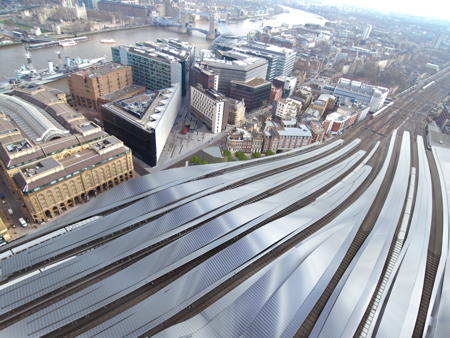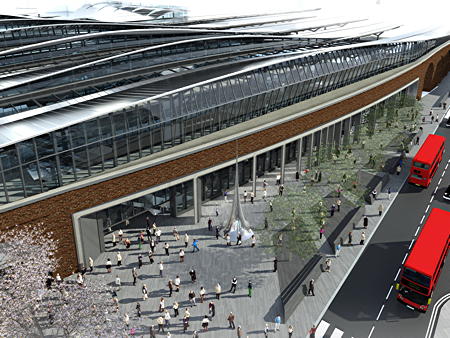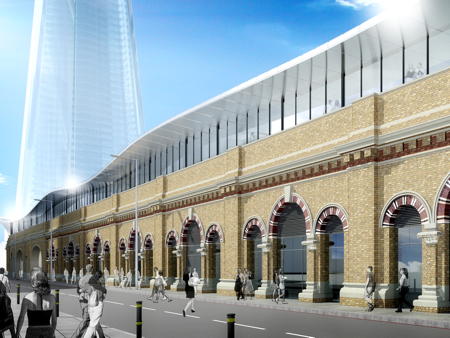London Bridge Station redevelopment gets green light from Southwark councillors
Plans for a major redevelopment of London Bridge Station - including demolition of the South Eastern Railway offices in Tooley Street and permanent closure of Stainer Street and part of Weston Street - have been approved by Southwark's planning committee.





The planning committee approved the proposals – designed by architects Grimshaw – by five votes to two at a packed meeting held on Tuesday night at the council's Tooley Street headquarters.
Preparatory work will start after the Olympic Games next summer and major work will begin in 2013. The station is due to be completed in 2018.
Introducing the four linked applications before the committee, planning officer Bridin O'Connor explained that the scheme has three main elements.
The first is the construction of a new street-level concourse to be created by removing the railway arches between Stainer Street and Weston Street, and the opening up of some of the vaults between Stainer Street and Joiner Street to create a new shopping area.
The second component of the scheme is the realignment of all the railway tracks running through the station. There are currently six through platforms (for trains to Charing Cross, Cannon Street and Blackfriars) and nine platforms for terminating trains. When the station is redeveloped there will be nine platforms for through trains and just six for services which have London Bridge as their destination. This aspect of the proposal doesn't require permission from the council as it was approved by the Government under the Transport and Works Act.
The third aspect of the station redevelopment is the proposed series of undulating canopies above the new platforms. Each platform will be covered along its full length but there will be no overall station roof.
Recommending the scheme for approval by members, Ms O'Connor said: "London Bridge Station as it currently exists is the culmination of incremental change over almost 200 years.
"Its functioning is highly problematic whether in terms of train services or passenger circulation.
"This scheme provides the opportunity to address many – if not all – of the shortcomings of the functioning of the station and will facilitate a station fit for purpose and fit for the 21st century."
She added: "Although there are some disbenefits in terms of heritage, the merits of the scheme are considerable and clearly weigh in favour of approval."
The committee spent some time discussing the impact of the redevelopment on traffic in the area.
Whilst the closure of Stainer Street and the northern section of Weston Street will be permanent, St Thomas Street will also be closed to through traffic for six years while works are carried out.
Westbound traffic along Crucifix Lane will be diverted northbound via Bermondsey Street to reach Tooley Street.
For eastbound traffic approaching from Borough High Street or Southwark Street the impact is more severe. The signed diversion route will send traffic – which currently uses St Thomas Street and Stainer Street to reach Tooley Street – via Great Dover Street and Bricklayers Arms instead.
Cllr Nick Stanton asked about plans for the relocation of Southwark Playhouse and Winston Churchill's Britain at War Experience. Ms O'Connor confirmed that negotiations between Network Rail, the theatre and the museum are ongoing.
What the objectors said
The meeting was addressed by two objectors who focused on concerns about the demolition of historic parts of the station complex.
Russell Gray, founder of Bermondsey Village Action Group, explained that his campaign group had collected nearly 5,000 signatures on a petition calling for the South Eastern Railway building on Tooley Street and the flank wall of the trainshed roof on St Thomas Street to be incorporated into the new station.
"We acknowledge the benefits of the station redevelopment but we stress that despite continued suggestions that they are incompatible with the preservation of heritage assets, they are actually entirely compatible," he said.
He called for the application for deferred for "proper, objective and independent evaluation" of Network Rail's case for the demolition of the structures.
Southwark-based architect Benedict O'Looney, chair of the borough's conservation areas advisory group, spoke up in favour of the retention of the South Eastern Railway building which he said is "as good as any building you will find on the Grand Canal in Venice".
He praised the building for its "warm and cheerful contribution" to the Tooley Street conservation area and reminded members that it was designed by Charles Barry Junior, son of the architect of the Palace of Westminster.
Under questioning from members, Mr O'Looney cited the example of the Great Northern Hotel at Kings Cross where the ground floor has been turned into an entrance to the new station concourse and called for a similar approach to be taken at London Bridge.
Mr O'Looney highlighted the importance of the view from City Hall through the More London estate towards London Bridge and argued for an approach that balances heritage and modernity.
"A bit of the old, a bit of the new – that's Southwark, right? What's so wonderful about the north part of our borough is the way we've been able to conserve some of the best Victorian buildings."
Summing up, Mr Gray said: "We absolutely resist the idea that there has to be a compromise to the benefits to save the heritage."
The case for change
The committee also heard from Network Rail's Simon Blanchflower who explained why there is a pressing need for the proposed redevelopment.
"Earlier this month Transport for London released stark information about the difficulty in managing London Bridge Station during the Olympic Games next year. This is a portent of the future," he said.
"The current station already struggles to cope with the level of demand placed on it. Without action there will be closures at the peak times in the morning and evening, affecting businesses and people in the local area and beyond.
"That is why today is so important. The scheme before you is one of the most critical schemes anywhere on the railway network."
He explained how the new station fits into the £6 billion Thameslink Programme which will increase capacity on the north-south rail link. At present only one or two trains an hour can run between London Bridge and Blackfriars during peak times.
"These plans offer the potential for a train every three minutes – effectively a new tube line for Southwark."
Mr Blanchflower was questioned by Cllr Robin Crookshank Hilton about the proposed demolition of the South Eastern Railway offices. He said: "All the advice we are getting is that ... the complexities of passenger movement in that area actually preclude the retention of that building if we want to maintain a safe environment for passengers."
Ward councillors warn of traffic chaos
The station straddles the boundary between Grange ward and Riverside ward so councillors Mark Gettleson and Anood Al-Samerai both appeared before the committee to register their concerns about the impact of the proposals on traffic flow in the area.
Cllr Gettleson said that he spoke for residents of the London Bridge area "who are terrified of further chaos in addition to our already congested and dangerous streets".
He pointed out that his ward includes both the "comparatively tranquil" Bermondsey Street and the "dangerous and congested" Tower Bridge Road.
"Members of the committee will have heard of the tragic death of the 22-year-old cyclist Ellie Carey earlier this month. We must ensure that any displacement of traffic onto Tower Bridge Road does not lead to more tragedy."
"For the sake of residents, pedestrians, cyclists and the local economy, we must get this right."
Cllr Gettleson quoted from a study carried out on behalf of Network Rail which anticipates major increases in traffic levels on local streets when the road closures come into force.
"During the construction period the study predicts a 73 per cent on the main stretch of Bermondsey Street in the evening, and 59 per cent on Long Lane," he said.
"One of the projections for Bermondsey Street traffic flow post-construction is 315 per cent."
He called on the committee to compel Network Rail to produce a "full new independent traffic management study" before construction starts – and to implement any necessary mitigation measures at their expense.
Cllr Al-Samerai spoke about her discussions with local businesses which will be displaced by the development. She made a special mention of On Your Bike, one of the longest-established businesses which will be affected by the development.
Decision time
After further discussion the committee voted by 5 to 2 to accept the officers' recommendation to resolve to grant planning permission. The council's decision is subject to referral to the Mayor of London and won't be finally signed off till some time in the spring.
Cllr Robin Crookshank Hilton explained why she voted against approval of the scheme. "I feel that in principle demolition of 64-84 Tooley Street constitutes a form of architectural vandalism," she said. She added that she was willing to be persuaded that its demolition was necessary but had not been convinced by the quality of the architecture of the proposed Tooley Street entrance to the station.
Reaction to the decision
Network Rail has welcomed the committee decision. Chief executive David Higgins said: "London Bridge is one of the busiest stations in the country and this investment is vital for passengers who want more space, less congestion and better services.
"Our proposals will breathe life back into London's oldest rail terminus and help build on the programme of regeneration along the South Bank and Bankside. It will provide a focal point for the local communities it serves as well as the tens of millions of passengers who use it every year.
"We are grateful for the support we've received and will continue to work closely with our partners and the local authority to deliver the project efficiently and considerately over the coming years."
The approval of the scheme has been welcomed by the local business community.
"The local business community sees the new station as vital to the success of the area and a catalyst for further redevelopment," says James Dinwiddie, chair of Team London Bridge.
"We have lobbied strongly for improving this crucial transport hub for some time and, in partnership with Network Rail, will be ensuring that the needs of businesses are incorporated into the new station."
Cllr Peter John, leader of Southwark Council, said: "The transformation of the London Bridge Quarter is interlinked with the vision we have for the borough as a whole – unlocking Southwark's potential to create and build upon sustainable communities, to ensure a fairer future for all.
"New public transport hubs are hugely important in drawing people into what is a borough already becoming famous for large-scale regeneration projects. I'm delighted that further progress can begin now that the application has been approved."
Comments
Share
The SE1 website is supported by people like you
More to read
- TfL proposes to reroute bus route 344 away from Southwark Bridge 27 Feb 2023
- Police launch crackdown on 'organised begging' at London Bridge 25 Jan 2023
- Colechurch House: Foster plans for London Bridge site approved 14 Sep 2022
- Shard restaurant: nearby tower could 'fatally undermine' eatery 7 Sep 2022
- Green light for 27-storey office block by London Bridge Station 21 Jul 2021
- Visitor information kiosk opened at London Bridge Station 4 Jul 2021
- South African variant of COVID-19 found in South Bermondsey 6 Apr 2021
- COVID-19 testing centres open at London Bridge and Waterloo 28 Feb 2021
- Waterloo's wooden WHSmith kiosk to be restored by railway museum 17 Jan 2021
- London Bridge: Man punched in face 'for not wearing face mask' 19 Oct 2020
Follow us
Email newsletter
For the latest local news and events direct to your inbox every Monday, you need our weekly email newsletter SE1 Direct.

